Nanjing SightseeingLearn About Nanjing's Impressive History and Immerse in Chinese Culture
Zhongshan Mountain is situated on the eastern outskirts
of Nanjing. Originally called Jinling Mountain in ancient times,
this mountain has been renowned as one of the "Four famous mountains
in areas south of the Yangtze River" since the Han Dynasty.
Also named Purple Mountain due to its peak frequented by purple
clouds, it covers an area of 31 square kilometers, with the main-peak
towering 448 meters above the sea level. Opening Hours: 6:30 am - 6:30 pm
Opening Hours: 8:30 am- 4:30 pm (Closed on Monday)
Nanjing has a city wall which, for the most part built in the Ming Dynasty by 200,000 labourers over a period of 21 years, has since seen parts of the wall being demolished or dismantled as a result of natural disasters, wars or political turmoil. The surviving section of the wall is now protected by the municipal government. It spans 33.5 kilometers in length and is in good shape. The gates, left almost intact, include Zhonghua Gate, Yijiang Gate, Xuanwu Gate and Zhongshan Gate. The city wall is 12 meters tall and usually 7.62
to 12.19 meters thick. The brick used to assemble the wall weighs
roughly 15 to 20 kilogram and was carved with dates and names,
which indicated when, where and by whom the brick was made. Address: South of Nanjing City, Nanjing
The construction of the palace started in the Spring and Autumn Warlord Period, almost 2,500 years ago. Located in Nanjing's downtown area, the palace has been an imperial palace in the Ming Dynasty (1368 – 1644) and now serves as the Nanjing City Museum. The palace is actually a building complex and occupies a land of 40,000 square meters. The palace was once used as a provincial education facility and a worship place for Confucius. It is one of the best tourist attractions now in the city. Its collection of historical items in diverse fields offers locals and visitors an opportunity to learn about the history of Nanjing. Address: Mochou Road or Jianye Road, Nanjing
The Drum Tower (Gulou) is situated in the very center of Nanjing at the Gulou roundabout. The Tower was built in the 15th year of the reign of Hongwu during the Ming Dynasty (1382) and renovated during the Qing Dynasty. The Drum Tower is a beautiful classical two story building set amidst a pretty and secluded garden. The scale of the building is very unusual in Chinese architecture and the views from the top of the tower afford a great panorama of the city. The Tower originally housed two large drums, 24 small drums and other musical instruments. Today there is only one large but impressive drum remaining on the top of the tower. The drums were used to announce the arrival of the emperor and his court to Nanjing and to warn city residents of danger. There is also a lovely little tea and snack house up here, which is usually blissfully quiet!
Opening Hours: 8:00 am - 5:30 pm
Jiming Temple (Jiming Si) situated in the east of the city, is an ancient city Buddhist temple with a long history. During the Three Kingdoms Period, this site was an official garden belonging to the Wu State. A temple was first built on the site in 527 during the Liang Dynasty. This original temple was destroyed and renovated many times until 1387, where the 20th year of the Ming Emperor Hong Wu, had Jiming Temple constructed. Nearby this pretty little active temple is a Rouge Well, so called because the Emperor's concubine used to clean the well with her handkerchief and leaving the stain of her rouge behind. The Temple and the Rouge Well are nearby to Xuanwu Lake, in the northeast of the city.
Linggu Temple (the Soul Valley Temple) was established in the beginning of the Ming Dynasty with the name Kaishan Temple and was later relocated from its original location in 1367 as Emperor Zhu Yuanzhang chose this place to be his mausoleum. The temple also serves as a memorial hall for the army service men killed during the early civic war (the Northern Expedition Period) against the Qing Dynasty and the warlords, and during the Anti-Japanese War. One of the most interesting things you need to see is the "Beamless Hall" (Wuliang Hall), constructed during the Ming Dynasty. The hall is 22 meters high and 53.8 meters wide. It has three archways on the front and rear sides. The structure of the hall was built with only bricks from the bottom to the top completely, without a piece of wood or a single nail to bear its heavy roof. There are totally three vaulted doors on its northern and southern walls and many windows on its four walls. The hall has lasted without major maintenance for more than 600 years. It is a miracle of architectural design. Address: Zhongshan Scenic Zone, Nanjing
The Qinhuai River is the cradle of the culture of Nanjing. The Qinhuai River View Area has been the most flourishing place in Nanjing for more than 1,000 years and it is often referred to as the "ten kilometer pearl decorated curtain". The construction imitates the architectural style of the Ming Dynasty. The owners like to hang colorful balls and lanterns on the boats. At night, the light is reflected into the water and adds much vitality to Qinhuai River
Lying on the southern shore of the Yangtze River, Yuejianglou Tower is located in the northwest of the city. Combined with more than 30 historic relics in the park, the region has been listed as one of the 4-Star National Tourist Attractions and is one of the four most well-known towers in China. The tower is a building complex and has seven stories with a total height of 52 meters. It was designed and constructed based on the current understanding for structures and styles that were popular in the Ming Dynasty. Climbing to its top storey, a stunning view of the broad Yangtze River with all nearby landscapes will appear in the front of you. The Yuejianglou Tower, meaning "the tower for viewing the river", is on the summit of Shizishan Hill (Lion Hill) that is 78 meters in height. In Ming Dynasty (1368-1644), the first Emperor Zhu Yuanzhang defeated his enemy, the King Cheng Youliang, in this area. After establishing his Empire, the emperor ordered to build a tower on the summit of the hill to commemorate his victory. Address: No. 202 Jianning Road, Xiaguan District, Nanjing
The forest zoo is good for a family trip. Address: No. 129 Huangjiawei, Xuanwu District, Nanjing
Address: No. 63 Junzilan Garden, Nanjing
Since its opening in 2000, the Nanjing Underwater World has received tens of thousands of visitors each year. There is also a polar aquarium at the Nanjing Underwater World. Most of the new animals are from the northern polar region ranging from polar bears, northern sea lions, northern fur seals, Arctic reindeer, Arctic foxes, Arctic hares and ferrets. There will also be southern sea lions and emperor penguins from the frigid south. Address: No. 2 Zhongshan Ling Shifang Cheng, Nanjing
Address: No. 14 Daqiao South Road, Gulou District, Nanjing
Address: No. 53 Gong Yuan West Road, Qinghuai District, Nanjing
The Taiping Heavenly Kingdom was the residence of Xu Da, a Prince from the Ming Dynasty, as well as home to one of the rebel generals during the uprising. The sad but fascinating story of the Taiping Uprising is told here in pictures and relics, with English captions. The museum is well worth a visit. Opening Hours: 8 am – 4:30 pm
Founded in 1929, the Zhongshan Botanical Garden (also called Dr. Sun Yat-Sen Botanical Garden or Nanjing Botanical Garden) is the first national botanical garden in China. The garden was originally established in memory of Dr. Sun Yat-Sen, the first President of the Republic of China. Occupying 187 hectares, the garden is located in the eastern suburb of Nanjing in the Zhongshan Scenic Zone. Close to Mingxiao Mausoleum, the garden is positioned behind the Purple Mountain (Zijinshan Mountain), and in front of the Qian Lake. The garden is one of the four major botanical gardens in China with magnificent display and comprehensive functions including education and scientific research. It has a huge collection of about 3,000 living plant species belonging to 913 genera of 188 families. The Herbarium within the garden contains a total amount of 700,000 sheets of specimens. The garden has established five research institutions including the Ornamental Plant Research Center, the Medicinal Plant Research Center, the Plant Information Center, the Prestigious Laboratory of Plant Ex-situ Conservation of Jiangsu Province and the Herbarium Address: No. 1 Qianhu Houchuan, Nanjing
Situated 22 kilometers northeast of Nanjing City, Qixia Mountain (Sheshan Mountain) is dubbed "the most beautiful mountain in Nanjing". The mountain is 286 meters high and has three peaks - Dragon Peak, Tiger Peak and Fengxiang Peak. The well-known Buddhist temple, Qixia Temple, is located on the mountain. This temple was erected in 489 BC and was enlarged during the Tang Dynasty. It was once recognized as one of the Four Largest Temples in history. The temple was destroyed by fire during Qing Dynasty and reconstructed years later. The temple has a number of critical historic relics such as the Thousand Buddha Cliff, the Royal Stele and the Sheli Pagoda. The Qixia Temple Restaurant offers vegetarian foods for travelers. Recently, Chinese archeologists have found numerous ancient stone inscriptions carved on the cliffs of the Mountain. The cliff inscriptions were found during a research project for cultural relics and they could be dated back to the Northern and Southern Dynasties (960-1279). The archaeologists have also unearthed four grottoes and dozens of Buddhist sculptures in the grottoes. The mountain is popular for its maple trees. Each year, when the autumn arrives, thousands of local residents and visitors rush to the mountain to camp and to see the red and golden maple leaves, which covers the whole mountain. Address: Qixia Mountain (22 kilometers northeast of Nanjing),
Qixia District, Nanjing
The Purple Mountain Observatory (Zijinshan Astronomical
Observatory) is the most well-known observatory in China. Situated
on the third peak of the Purple Mountain, the observatory was established
in 1926 and is now under direction of Chinese Academy of Sciences.
It has been listed as one of the highest ranking research institutions
for astronomy and space sciences since then. It is also opened
to the public as a tourist destination.
Located in the city center of Nanjing nearby the ancient city wall, Xuanwu Lake is well known for its beauty and its surrounding environment, and is one of the three famed lakes in the South of Yangtze River. The lake occupies 3.7 square kilometers and is one of the largest comprehensive entertainment centers of the city. There are five green isles dotted in the lake, connected by bridges and dykes, and each of them displays its unique characters, diverse landscapes, gardens with different plant and flower species and rockeries. Jogging along its lake shore or sitting in a boat with your family or friends, you can see the crumbling ancient city walls, chrysanthemum show, God Temple, architectures and more. In the summer, one will never forget how the coolest wind blows away the scorching heat. Address: Xuanwu Gate, Xuanwu District, Nanjing
This bridge was built in the 1970s. It is the second bridge over Yangtze River after Wuhan Yangtze River Bridge. The bridge is a double-decker combined with a double track consisting of a highway and a railway system. It is 6,772 meters long and 160 meters wide, which can take 15 minutes to cross during regular traffic time. The bridge is entirely constructed by the Chinese themselves without external engineering assistance. The Chinese nationalities are very proud of the bridge even though it was not deemed great in many technical respects judged by modern technological developments. The bridge is the longest of its kinds in China and is a landmark for Nanjing. Address: Xiaguang District, Nanjing
The palace was originally established in the Qing Dynasty as the Yamen, meaning the government office, for the Governor General of two Provinces: Jiangsu and Zhejiang. It was also the traveling palace for two emperors of Qing Dynasty, Kangxi and Qianlong. It has a history of more than 600 years. The place now houses the China Modern History Museum that exhibits historical documents in China's recent history. Address: No. 292 Chongjiang East Road, Nanjing
Dr. Sun Yat-Sen's Mausoleum is situated at the southern foot of Zhongshan Mountain. Lying on the lower portion of the mountain, it looks out into the plain comprised of an elongated passage way immersed in the lush surroundings. The construction of the mausoleum started in 1926, and Dr. Sun Yat-Sen's coffin was subsequently moved here in 1929 from Beijing. The forever resting place of Dr. Sun Yat-Sen is in the circular coffin chamber north of the sacrificial hall. This tranquil area marks the remains of this great revolutionary and leader. Traveling along the marble road towards the mausoleum, you will first arrive at the half-moon square south of the mausoleum. Then at the entrance to the mausoleum you will see the great marble memorial archway. Through it extends the Passway of 480 meters long and 40 meters wide. Situated on the Passway is the Frontispiece combining three archway gates encased in copper. Four Chinese characters written by Dr. Sun Yat-Sen are inscribed on the doorways that translates to "The World Belongs to All", which signifies the cause he struggled for during his life. Passing through the Pavilion, you will next come across the sacrificial hall and in the center of it you will find a big statue of Dr. Sun Yat-Sen with a firm and sincere look on his face. Caressing an open book on his lap, he seems to be contemplating the present and future states of China. Surrounding the statue are sculptures demonstrating the revolutionary leaps that the giant had taken during his life. The texts etched on the walls reminded the visitors of his famous writings that embodied his political and philosophical ideologies. Address: No. 1 Zhongshanling Road, Nanjing
While Xuyuan Garden in Nanjing City, Jiangsu Province covers an area only a little more than four acres, it occupies an important place in Chinese history. Despite its relatively small size, it is also renowned for its unique southern China gardening style. Built during the Ming Dynasty (1368-1644), Xuyuan Garden derives its name from a prince, Zhu Gaoxu, who once lived there. Later the garden became the residence for the governors of Zhejiang and Jiangsu provinces. Xuyuan is also known as West Garden for it was located west of the palace of Taiping Heavenly Kingdom (1851-1864). The kingdom was established by a peasant leader, Hong Xiuquan, who then proclaimed himself the king. The garden later served as the presidential mansion of Dr. Sun Yat-Sen, the Interim President of the Republic of China (1912-1949). Visitors will find that Xuyuan Garden is the epitome of the modern history of China. Address: No. 292 Changjiang Road, Nanjing
Among the five most famous gardens of Southern China, Zhanyuan Garden is the only well preserved Ming Dynasty (1368-1644) architectural complex in Nanjing. It is the oldest (over 600 years) among all the gardens in the city. Emperor Qianlong of the Qing Dynasty (1644-1911) once came here and gave it the name of Zhanyuan. After the establishment of the Kingdom of Heavenly Peace (Taiping Tianguo in Pinyin, 1851-1868), it became the residence of the Taiping Rebellion leaders Yang Xiuqing, Xiao Youhe and Lai Hanying. With frequent wars, it lay deserted for many years until its restoration by the government in 1960. The garden is divided into two parts. The east part
is the museum where over 1600 cultural relics, including twenty
cannons, the imperial seal and robe of the Heavenly King, and the
flag and sword of the army of Taiping Tianguo are displayed.The
west part is typical garden scenery consisting of exquisite pavilions,
clear water pools, winding pathways and a variety of rockeries. |

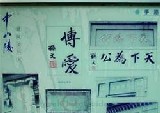 Nanjing
is a city of history and culture, where many historical sights,
memorials, museums and natural landscapes grab the attention
of travelers. People are lured by the ancient capital of China
and the beautiful scenery surrounding it. For example, the famous
Confucius Temple (Fuzimiao) is not only a memorial place for
the Great Sage in China but has a surrounding area bustling with
shops, restaurants and a snack street housed in traditional Chinese
architectural buildings.
Nanjing
is a city of history and culture, where many historical sights,
memorials, museums and natural landscapes grab the attention
of travelers. People are lured by the ancient capital of China
and the beautiful scenery surrounding it. For example, the famous
Confucius Temple (Fuzimiao) is not only a memorial place for
the Great Sage in China but has a surrounding area bustling with
shops, restaurants and a snack street housed in traditional Chinese
architectural buildings.  Originally
built in 1034, the Confucius Temple is a sacred shrine to Confucius,
who was a famous thinker and educator during ancient China. The
thoughts of Confucius are still highly appreciated by scholars.
This temple actually has a group of old buildings with the Temple
as the main construction. These structures have undergone countless
changes, being destroyed and rebuilt time and again. Now the Confucius
Temple is one of the most famous scenic spots in Nanjing.
Originally
built in 1034, the Confucius Temple is a sacred shrine to Confucius,
who was a famous thinker and educator during ancient China. The
thoughts of Confucius are still highly appreciated by scholars.
This temple actually has a group of old buildings with the Temple
as the main construction. These structures have undergone countless
changes, being destroyed and rebuilt time and again. Now the Confucius
Temple is one of the most famous scenic spots in Nanjing.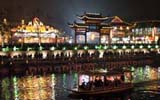 The Memorial Hall to the Victims in the Nanjing Massacre
was built by Nanjing Municipal Government in 1985 and extended
in 1995, covering an area of 28,000 square meters (302,400 square
feet). It is located in Jiangdongmen, one of the execution sites
and mass burial places of the massacre. Solemn and imposing, the
grey marble architecture consists of three parts: the outdoor
exhibits, the remaining bones of the victims and the exhibition
hall for historical documents.
The Memorial Hall to the Victims in the Nanjing Massacre
was built by Nanjing Municipal Government in 1985 and extended
in 1995, covering an area of 28,000 square meters (302,400 square
feet). It is located in Jiangdongmen, one of the execution sites
and mass burial places of the massacre. Solemn and imposing, the
grey marble architecture consists of three parts: the outdoor
exhibits, the remaining bones of the victims and the exhibition
hall for historical documents.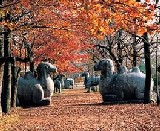 The
Ming Xiaoling Mausoleum is where Emperor Ming Taizu (respected
title of Emperor Zhu Yuanzhang) and his queen are buried. This
mausoleum lies at the northern foot of Purple Gold Mount (Zijinshan),
adjacent to Dr. Sun Yat-Sen's Mausoleum on the east and Chinese
Plum Mountain (Meihuashan) on the south. With a more than 22.5
kilometers wall, the mausoleum is the largest emperor mausoleum
in Nanjing. Most of its wood-structured buildings were destroyed
in 1853, but the brick and stone buildings are still in existence,
including the Rectangular City, Inner Red Gate and Jinyue Tablet.
The
Ming Xiaoling Mausoleum is where Emperor Ming Taizu (respected
title of Emperor Zhu Yuanzhang) and his queen are buried. This
mausoleum lies at the northern foot of Purple Gold Mount (Zijinshan),
adjacent to Dr. Sun Yat-Sen's Mausoleum on the east and Chinese
Plum Mountain (Meihuashan) on the south. With a more than 22.5
kilometers wall, the mausoleum is the largest emperor mausoleum
in Nanjing. Most of its wood-structured buildings were destroyed
in 1853, but the brick and stone buildings are still in existence,
including the Rectangular City, Inner Red Gate and Jinyue Tablet.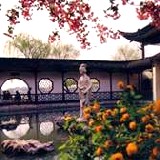 This
lake has a lakeside of 5 kilometers in all and covers a land and
water area of 40 hectares. It enjoys a fame of being the first
scenic spot in Nanjing. The lake has many beautiful stories; one
is about the Northern and Southern Dynasties (420 AD – 589 AD),
where a beautiful and intelligent girl, named Mochou, was happily
married to her husband in Nanjing at the age of 15. However, when
her husband was drafted for the battlefield, she never received
any messages from him. She cried, trying to turn the pool of water
into a waterway so she could go to where her husband was stationed.
With this legend, they named the lake after her. It turns out
that even though this was a legend, the lake is part of the 2,000
year old bed of the Yangtze River
This
lake has a lakeside of 5 kilometers in all and covers a land and
water area of 40 hectares. It enjoys a fame of being the first
scenic spot in Nanjing. The lake has many beautiful stories; one
is about the Northern and Southern Dynasties (420 AD – 589 AD),
where a beautiful and intelligent girl, named Mochou, was happily
married to her husband in Nanjing at the age of 15. However, when
her husband was drafted for the battlefield, she never received
any messages from him. She cried, trying to turn the pool of water
into a waterway so she could go to where her husband was stationed.
With this legend, they named the lake after her. It turns out
that even though this was a legend, the lake is part of the 2,000
year old bed of the Yangtze River
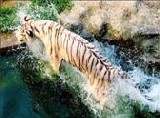

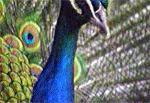 This park offers visitors to see many beautiful peacocks. There
is also a special performance where visitors can see peacocks
span their wings - a way for them to defend against their enemy
too. Their wings open to hold roughly 3 meters wide, roughly
1.5 meters high.
This park offers visitors to see many beautiful peacocks. There
is also a special performance where visitors can see peacocks
span their wings - a way for them to defend against their enemy
too. Their wings open to hold roughly 3 meters wide, roughly
1.5 meters high. 
